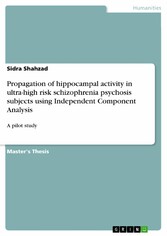Search and Find
Service
Propagation of hippocampal activity in ultra-high risk schizophrenia psychosis subjects using Independent Component Analysis - A pilot study
More of the content

Propagation of hippocampal activity in ultra-high risk schizophrenia psychosis subjects using Independent Component Analysis - A pilot study
Master's Thesis from the year 2017 in the subject Psychology - Clinical Psychology, Psychopathology, Prevention, grade: Merit, King`s College London, language: English, abstract: Schizophrenia is described as an incapacitating, chronic and severe mental illness which affects about 1% of the population. Among the most frequently prominent of the cognitive symptoms in schizophrenia are deficits in working memory. More recently, individuals at ultra-high risk (UHR) of psychosis have been proposed to help provide awareness on the nature of prodromal stages and further acknowledge the initial stages to offer possibilities for early and more distinct interventions. It is particularly critical to perform studies on UHR of psychosis subjects as around 30% of UHR people experience progression into psychosis within two years. A pilot study was conducted (8 females, 4 males) to examine visual P300 amplitude and detect hippocampal activity through scalp EEG, using the ICA analysis methodology. A smaller separate study was also conducted amongst UHR subjects (3 males, 1 female) and controls (2 males, 1 female). Findings revealed a pattern of high amplitude positivity across the ipsilateral anterior basal temporal, and mid parietal electrodes, alongside a low amplitude positivity, distributed around the cheekbones; similar patterns were identified in UHR subjects. UHR subjects displayed a higher P300 amplitude compared to controls, contrary to previous findings. The results of the present study provide a stepping stone for future studies to conduct further research incorporating additional source localisation analysis such as sLORETA. Understanding the location of the source of the P300 could allow prospective studies to determine and predict conversion to psychosis and act as possible biomarkers of psychosis amongst individuals with UHR, allowing a platform to provide early interventions for these at-risk individuals.
All prices incl. VAT











